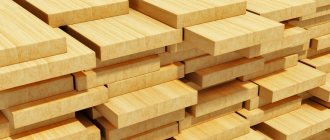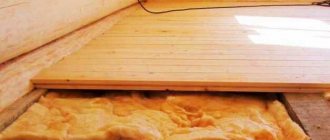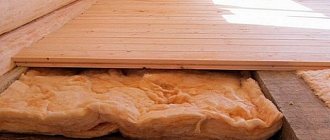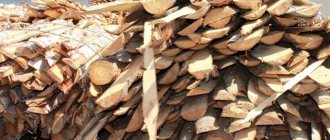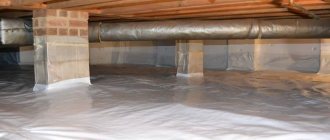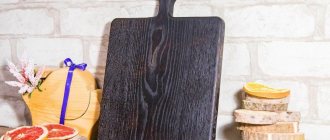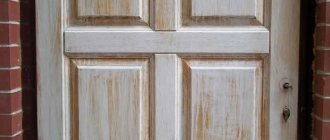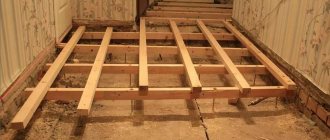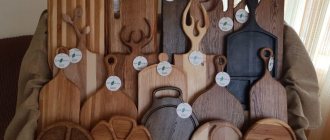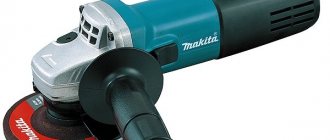Many owners of private houses (like me) prefer classic wooden flooring to the rest of the variety of finishing floor coverings. Unlike laminate and linoleum, a worn-out plank or parquet surface can be renewed, and here the question often arises of how to sand a wooden plank floor. The update process consists of simple steps, but has its own specifics; Therefore, I want to tell you how to restore the floors to their former attractiveness.
Source zhkpribrezhny.rf
Sanding: when is it needed?
Sanding a wooden floor can solve two problems:
- When laying a new coating, it levels the surface, eliminating minor defects and height differences between individual elements.
- Prepares old flooring for renewal: removes dirt and consequences of use (for example, scratches), levels, removes old paintwork. Then a decorative protective composition (varnish, wax, oil) is applied to the surface.
Various sanding tools are used to process the floor. In some situations their use is unjustified. Sanding will not help if there are fairly wide gaps between the dies or boards (wider than 6-7 mm). Defects of this kind arise after long-term use, and it is unlikely to be possible to repair them with sealant or putty if the wood turns into dust.
Therefore, the floor is inspected to determine its condition, and a method for eliminating defects is chosen. You may need to redo the floors, replace damaged areas, or simply fill large gaps with wood inserts.
Source mosoblzhilservis.rf
Old, worn-out floors can be problematic for treatment if areas of intensive use are at least 0.4 cm below the main level. Damaged areas will have to be reanimated and replaced with new material. Also, a sanding machine cannot smooth out damage in the thickness of wood, deep scratches or mold; Grinding is carried out only after the defects have been corrected.
Mistakes when working independently
Many craftsmen make the following mistakes when grinding on their own:
- poor preparation of the base;
- incorrect choice of grinding machine;
- excessive pressure on the grinder, which causes it to overheat.
Home craftsmen do not always have special grinding equipment available, which affects the quality of the coating. Most often, floor treatment is performed with an angle grinder, which requires certain work skills. If handled improperly, the tool leaves marks on the surface that spoil the appearance of the floor. In addition, when grinding with an angle grinder, a huge amount of dust is released, which significantly complicates the processing process.
How to grind: manual and machine approach
The answer to the question of how to sand a wooden floor may vary, depending on the expected amount of work. In practice, two types of grinding are used:
- Manual . The method is used if it is necessary to treat a small area or hard-to-reach places. The method is budgetary, but time-consuming and labor-intensive.
- Machine . There are a variety of units that allow you to quickly and efficiently process large areas and hard-to-reach places. It is difficult to say whether it makes sense to purchase such specialized and expensive equipment in each specific case. But you can always rent it, and the price will be reasonable.
Source dobrzemieszkaj.pl
The owner who decides to sand the floors by hand has the following tools at his disposal:
- sandpaper (abrasiveness index 40-120). The choice of grain size and consumption depends on the floor area, the size of the defects, as well as the thickness and strength of the old paint layer.
- Grater-rasp . Hand construction tool (originally finishing, to create roughness). It is made of plastic (size about 130x170 mm), the working blade is made of galvanized steel, with teeth of an uneven structure. You can make your own grater from wood and wrap it in sandpaper.
- Cycle . A classic instrument from the pre-machine era. A steel plate with a curved sharp edge is fixed to a handle made of wood or plastic. There are different sizes of instruments available on the market; With the help of a scraper you can not only scrape off varnish and other paintwork materials, but also cut or lift up protruding wood fibers.
Electrical equipment used for sanding wooden plank floors is quite varied in design. But the machines operate in the same way: using sandpaper they erase the top layer of wood.
Source doska-parket.com
To navigate the choice, it is useful to consider the operation of grinding machines from the practical side:
- Drum type sander . The working surface is a cylindrical shaft covered with abrasive paper. The tool is intended for primary, rough processing; it removes wood in a thick layer. Available in a wide range, with single- or three-phase connection, in household or professional versions; devices are expensive and heavy.
- Tape type . The abrasive blade is fixed to the working sole and moves between two moving rollers. In terms of range, size and price, it resembles drum-type devices. Some manufacturers offer compact tape models with a low weight (4 kg).
- Surface grinding (vibrating) machine . The working tool is a vibrating surface (sole) that makes small “troweling” movements during operation. Used for secondary processing of wooden surfaces. A variation, the delta grinder, thanks to the narrowed shape of the sole, processes hard-to-reach places (along walls, under radiators).
Source pol-pro.com
- Angle grinder (grinder) . Although this is not a specialized tool, it is useful for sanding a small or hard-to-reach area.
Selecting boards
To install the floor covering, you must first decide how to cover the tongue and groove floor so that it is as reliable as possible. When choosing boards, you need to take into account several parameters:
Wood type
This parameter directly affects the quality and characteristics of tongue and groove boards:
- Spruce and pine. The main quality for which coniferous trees stand out is their low cost. In addition, spruce and pine boards retain heat well, even in the coldest times. Among the disadvantages of such boards, one can note their poor wear resistance: any point loads, such as furniture legs or fallen objects, will immediately affect the wood. Also, softwood boards should not be used in high traffic areas.
- Larch. Being a hard conifer, larch differs from spruce and pine in its durability and good resistance to moisture. In addition to its strength characteristics, this breed has good visual qualities, so it does not require additional varnish treatment.
- Oak and ash. Boards made from these types of wood are distinguished by their utmost quality and reliability. Pleasant texture and noticeable shade are also advantages. The disadvantage, based on all the positive qualities, is obvious - oak and ash boards are much more expensive than their coniferous counterparts.
Board sizes
You need to select the dimensions of the boards depending on the size of the room in which they will be laid. It will be much easier and more convenient to lay boards whose length matches the length of the walls along which they are laid. The thickness of the boards affects their cost and reliability.
Standard sizes of tongue and groove boards range from:
- Length – from 1 to 6 m;
- Width – from 70 to 200 mm;
- Thickness – from 18 to 45 mm.
Quality class
This indicator allows you to select boards depending on their purpose and quality requirements.
Tongue and groove boards are divided into four classes:
- Extra class (Eurospunt). Such boards are distinguished by the highest price, but at the same time they are distinguished by their uniform structure, shade and absence of flaws.
- A-class. A cheaper option, which also does not have cracks or knots, but may have an uneven shade.
- B-class. This quality class allows for the presence of small stains and small cracks on the surface of the boards.
- C-class. The cheapest material, which has all sorts of defects: knots, cracks and small single holes. As a rule, economy class boards are used to create a subfloor.
Humidity
This aspect is incredibly important for tongue-and-groove boards: poorly dried boards will certainly become deformed after installation and begin to rot, and eventually the entire floor will have to be re-laid.
It is for this reason that before attaching a tongue-and-groove board to joists or another base, you need to monitor the moisture content of the material using the following recommendations:
- A suitable moisture content for boards is about 12-16%. To determine this parameter, it is best to use a moisture meter, and if you don’t have one, you will have to use simple but effective methods:
- Lightly tapping dry wood will give a clear and ringing sound, while wood that is too wet will sound dull and almost inaudible;
- Wet boards usually feel quite damp to the touch. Well-dried boards do not give this feeling;
- A dry board usually has a lighter shade than a wet one. In addition, a dried board after high-quality processing begins to shine slightly, while a board with a high moisture content looks completely dull;
- If condensation collects on the inside of the board packaging, it always means the boards are too wet.
Tools and materials
A grinding machine is a necessary, but not sufficient condition for obtaining a high-quality result. Before sanding a wooden floor, you need to prepare the following tools and materials:
- Hand scraper and scissors for cutting sandpaper.
- Sandpaper of different grain sizes (No. 40-120), you will need a lot of it.
- Construction vacuum cleaner. It can be replaced with a household unit, the main thing is more power.
- Wood putty, parquet varnish, brushes or roller.
- Personal protective equipment (respirator mask, goggles).
Source ab-cleaning.ru
Advantages and disadvantages of tongue and groove flooring
- The tongue-and-groove connection ensures uniform load distribution on the boards and increases their service life.
- There are special grooves on the back side of the board to supply air to the underside of the material, which prevents the appearance of fungus.
- The covering made of tongue and groove boards has good sound and heat insulating properties.
- Thanks to the tongues and grooves, installation of the material is very fast.
- Tongue and groove boards are produced in standard sizes, which also speeds up installation work.
- The board is made from a single solid wood, without the use of chemical components.
- The coating has a beautiful appearance.
- Boards connected by groove and tongue do not deform or warp.
- The tongue and groove boards form a durable, seamless coating.
- To restore its attractiveness, it is enough to cycle or sand the front side and cover it with drying oil or special varnishes.
- The boards comply with European standards. The front part is smooth, does not require additional improvement, and paint or varnish lies perfectly smoothly on it.
- There is always a healthy spirit in rooms with natural wood floors.
- A tongue and groove floor looks good in any room decor.
- The joining elements (groove and tenon) are made on a high-precision milling machine, so the quality of the connection is very high.
Preparation
Before sanding a wooden floor from planks, it is prepared for work as follows:
- Furniture is taken out of the room, baseboards are dismantled.
- Clean the floor from the old decorative coating (varnish or paint) using a solvent or a hair dryer (after heating, the old layer is removed with a spatula).
- Check the coating fasteners (nails, screws): a cap sticking out above the surface can lead to breakage of the grinding unit.
- If necessary, putty the cracks or dismantle the floors (move the boards to install an additional lath). Weak parquet strips are secured with self-tapping screws.
- Use a vacuum cleaner to remove all debris from the floor and close the gap under the door (protection from drafts).
Source myfirstapartment.com
Surface degumming
Conifers are known to contain large amounts of natural resins. On the one hand, this circumstance is an advantage, since the resin content protects the tree from rotting and mold formation. But on the other hand, resin prevents good adhesion of paint to wood, and when sanding it spreads over the surface and spoils the appearance of the wood. Therefore, before processing the needles with a grinder, it is necessary to remove excess resin.
How to remove resin from a log before sanding? Suitable solvents for this are: acetone, white spirit, turpentine, purified gasoline. You just need to apply the selected product to the wooden surface, and rinse off the residue with warm water.
Grinding technology
Processing a wooden floor with any sanding technique consists of several stages. First, rough grinding is performed with a coarse abrasive (No. 40), then it is successively changed to abrasives No. 60, 80 and 100-120. Sanding the floor with a grinding machine is performed in the following order:
- According to the instructions, a sheet of coarse sandpaper is inserted into the machine.
- The unit is tilted (to lift the working surface off the floor) and turned on, then smoothly lowered. The machine should not stand still while it is turned on - you will get deep defects that are difficult to fix.
- The machine is driven along the fibers (when laying decks), and circular movements are performed on the parquet. In this case, you need to ensure that the machine moves, partially covering the already sanded area.
- With each sandpaper number, make three passes, after which the number is changed. Before the last pass, putty the cracks and wait until dry.
- At the end of sanding, collect dust with a vacuum cleaner and finish with varnish or paint.
Source pinimg.com
About sanding a wooden floor in the following video:
Types of grinding machines
Grinding machines come in several varieties:
- surface grinding;
- drums;
- corner.
Surface grinders are used to process floor boards laid using the floating method.
To process thick floors, drum type grinders are used, weighing about 80 kg. Such devices are used to process floorboards, but they are not suitable for working with parquet flooring.
Device for processing thick floorboards
This machine has a screw with which the degree of load on the engine is adjusted.
The operation of the drum should be monitored to prevent overload and spontaneous shutdown of the machine.
If the voltage supplied to the device is not high enough, the machine will not be able to operate at full capacity. In this case, you should release the pressure on the engine and also disconnect all electrical appliances from the network. If this does not work, you may have to look for an alternative power source.
Grinding in hard-to-reach places is done using corner-type machines, popularly called “boots”.
Briefly about the main thing
Sanding restores the wooden floor to its former attractiveness. For updating, grinders, sandpaper, grater and scraper are used. Before starting work, the floor is cleared of debris and, if necessary, the boards are puttied or sorted out. The grinding technology is the same for all brands of machines; it is important to change the sandpaper on time (from coarse to fine). The finished surface is covered with finishing.
Question
Write in the comments what you think - is it useful for a machine to be able to adjust the pressing force of the abrasive?
Repair of tongue and groove floors
A tongue-and-groove floor is a fairly reliable coating, but sometimes troubles arise: individual tongue-and-groove floorboards become unusable over time. If we are talking about one or more boards, then they can be removed from the floor and replaced. To do this, you need to cut the ridges of the boards with a circular saw that has a rounded end of the blade. The circular saw can be replaced with a jigsaw or a narrow hacksaw.
Replacing the boards directly is simple: making small cuts on the board, using a chisel to knock out all the ridges in them. The damaged board is removed, the grooves are cleaned of remnants of tenons, and a new one is installed in place of the board, and the flooring again performs its functions to the fullest.
Advantages of renting
A floor sanding machine is worth the money spent on it only for companies whose specialization is directly related to carrying out a certain list of works where it is impossible to carry out specific tasks without a grinding machine.
It is advisable to rent a grinder if:
- It is necessary to complete a large amount of work as soon as possible.
- The available equipment is out of order, and it is absolutely impossible to suspend work.
- Your company has a list of non-core work, and you are able to carry it out because you have the necessary staff and time.
- Too much work was taken on - as a result, there is not enough equipment, and there is simply no time to replenish the fleet of equipment.
- You plan to master this type of business, but to understand how everything works and whether it will be profitable, you need to do a small amount of work
The grinder will be needed by employees of companies who are constantly faced with work related to:
- laying and sanding parquet flooring in houses and apartments;
- construction and turnkey finishing of dachas and country wooden houses;
- pouring concrete and mosaic floors with subsequent grinding;
- laying and polishing granite and marble floors;
- installation of polymer self-leveling floors.

